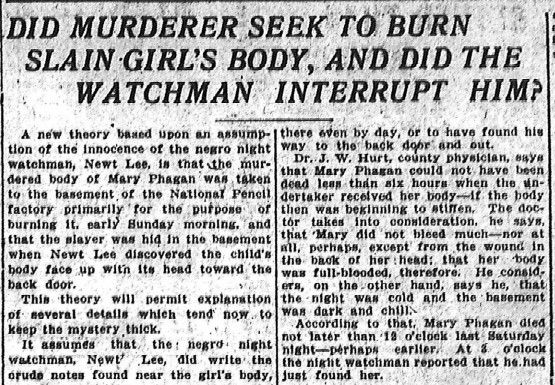Another in our series of new transcriptions of contemporary articles on the Leo Frank case.
Atlanta Journal
Thursday, May 1st, 1913
A new theory based upon an assumption of the innocence of the negro night watchman, Newt Lee, is that the murdered body of Mary Phagan was taken to the basement of the National Pencil factory primarily for the purpose of burning it, early Sunday morning, and that the slayer was hid in the basement when Newt Lee discovered the child’s body face up with its head toward the back door.
This theory will permit explanation of several details which tend now to keep the mystery thick.
It assumes that the negro night watchman, Newt Lee, did write the crude notes found near the girl’s body, but wrote them to save himself from the first fury of suspicion, believing that his innocence would be established by later calm investigation. The assumption that he did write them is reasonable, because in the notes themselves and in the negro’s repetition of them, “by” was spelled “boy” and “self” was spelled “slef.” The final “f” on “slef” is identical in the original and the test, moreover; and other details seem to indicate they were written by the same hand—that of the negro.
THEORY IN DETAIL.
Here, in detailed sequence, is the new theory:
The murderer faced the necessity of removing his victim’s body from the second floor and disposing of it.
Either before the negro came to work, or afterward while the negro was on the upper floors, the murderer took the body to the basement, probably by way of the trap door and ladder.
There he dumped the lifeless form of the child upon a pile of trash and papers and other clutter in front of the firebox beneath the boiler. Mary Phagan’s hat and her left shoe were found there.
Planning to dismember the body or stuff it somehow into the unlit firebox and there consume it by burning it in a hot fire of trash, the murderer was interrupted by a noise at the trap door near the front. A gas-jet, burning dimly there, was the only light in the thick gloom of the place. Another light, the watchman’s lantern, showed in the opening. The watchman was coming down.
The murderer seized the child’s body quickly by its dress, or an arm or a leg, and whisked it across the dirt floor, past the boiler and around the corner of the partition, there dropping it out of sight as he thought. A place that looked as though something had been dragged upon the dirt floor was found by the officers, and at least one of them swore to it Wednesday at the coroner’s inquest. The child’s clothes, her face, one of her legs, were rubbed black with the black dirt and coal dust of the floor of the place. She was found lying, not upon that black dirt, but upon dirty sawdust.
MURDERER HID.
The watchman came on back toward the rear, and the murderer fled from his corner into the wood-dust bin beside the back door. In that are piles of dust from the pencil-wood machines upstairs. A chute empties the dust there. The bin is an ideal hiding place. The sawdust underfoot permits no sound.
There the murderer crouched when the watchman discovered the body with its face up, head toward the back.
The watchman, a negro, saw that flight for himself would be a confession of guilt. To report the find would be to invite unknown trouble. He had to choose. He chose the latter—but wrote a note, then another, to divert the first fury of discovery from himself.
It would have been easy for the negro to have carried the girl’s body out of the back door, across the alley, and deposit it somewhere else outside in the neighborhood. But he did not do that. Would he not have done it if he had been guilty?
The murderer saw the watchman leave, and the basement was pitch dark again. He emerged, picked up the body to hide it somewhere else or do something with it; dropped it—upon its face, head toward the front, as it was found by the officers; and escaped by pulling a staple from the rear door, stepping out into the alley, and becoming lost in the city immediately.
There are two psychological factors which govern the whole case.
TWO GOVERNING FACTORS.
It is not probable that an outsider would have been interested enough in the consequences of Mary’s body being found in the factory, to hide it or move it anywhere or dispose of it in any way. His sole object would have been to escape with his own hide.
Further, it is not probable that a person unacquainted with the premises would have been able to penetrate to the cellar in the gloom that prevails there even by day, or to have found his way to the back door and out.
Dr. J. W. Hurt, county physician, says that Mary Phagan could not have been dead less than six hours when the undertaker received her body—if the body then was beginning to stiffen. The doctor takes into consideration, he says, that Mary did not bleed much—nor at all, perhaps, except from the wound in the back of her head; that her body was full-blooded, therefore. He considers, on the other hand, says he, that the night was cold and the basement was dark and chill.
According to that, Mary Phagan died not later than 12 o’clock last Saturday night—perhaps earlier. At 3 o’clock the night watchman reported that he had just found her.
* * *
Atlanta Journal, May 1st 1913, “Did Murderer Seek to Burn Slain Girl’s Body, and Did the Watchman Interrupt Him?” Leo Frank case newspaper article series (Original PDF)

